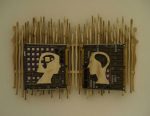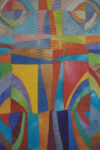The path into spooky kitsch is littered with the shelly husks of corroded tin robots, while a soundtrack is played in REAL STEREO by a Regina Music Box endlessly performing from a cylinder alternately spun by the three norns of Americanum Fantasticum: Ray Bradbury, Rod Serling, and Philip K. Dick. It’s night time and the . . . → Continue reading: Wherefrom come thou, Glock Frauenzimmer?
|
||

F. Spume inquires, I’m looking for music from the seventies that are similar to Kraftwerk. I’m a sucker for robot music/old electronic and I thought I would throw this out there. I’ve already discovered Telex, Yellow Magic Orchestra, Jean-Michel Jarre, and more recently Roberto Cacciapaglia’s Anne Steel album. I’m even down with 80’s music like . . . → Continue reading: Robot Musics (for Fistula Spume) I picked up the compilation Ohm: The Early Gurus of Electronic Music from my local library a few years agoon the recommendation of a friend. I was prepared to be educated. I knew not to expect beautiful, haunting melodies as on Harold Budd and Brian Eno’s Plateaux of Mirror as I had already experimented with . . . → Continue reading: François Bayle and Laurie Spiegel 
I’m listening to Trans Harmonic Nights by Peter Baumann (1979) and it’s hard to miss why Tangerine Dream sounded so much better before he left that seminal electronic-space jam band in 1977. The artist knew how to sequence baroque melodies and sing lullabies into vocoders. Baumann must have been an incredible catalyst for Tangerine Dream . . . → Continue reading: Baba O’Riley and Peter Baumann 
I listen to the punctuated tones and hypnotic melodies of gamelan music and I begin to understand why I become so flustered when trying to describe ambient to friends (and relatives, co-workers, strangers on blogs and listserves). Ethereal, atmospheric, and drone sounds also describe elements of the ambient spectrum, and in a way sets it . . . → Continue reading: Gamelan, Xylophone, and Computer Kitsch 
Next to a Rainbow in Curved Air by Terry Riley (1968) my most favorite album (with a rainbow in the title) is Rainbow Dome Musick by Steve Hillage (1979), a magnificent two tracks/two sides album from the Canterbury school of progressive rock. I don’t really know whether to give credit to Brian Eno for . . . → Continue reading: Ggggong-go-long 
I don’t have too much to say about the genre of new Jazz fusion other than to point out certain tracks by Jean-Luc Ponty that absolutely stand out. Check out if you can, “No More Doubts” from his otherwise unremarkable 1987 album The Gift of Time. Jean-Luc Ponty helped to popularize the electric violin playing . . . → Continue reading: Jean-Luc Ponty 
I do not want these albums to be obscure, but they are. Even the ones I take for granted — by famous bands like Kraftwerk, remain unknown to so many! This is why musical evangelism is so important. Lacking magic and prophecy, we have the next best thing, perhaps the only thing: art. And . . . → Continue reading: Music Evangelism 
Part of the mystery of progressive rock in the 70s and early 80s were bands covering Beethoven and J.S. Bach. Listen for example to “Beethoven’s Ninth Symphony” on Jethro Tull’s A Sackful of Trouser Snakes (1977) or “Cans and Brahms” on Fragile by Yes (1972). In prog circles, this sub-genre is often referred to as . . . → Continue reading: On the lookout for electro-baroque (und beethoven) So David Hyman, whose project we enjoy in this here website, messaged me after reading my earlier blog post. He had some corrections. See below. I had made a point in Hyman not having mentioned last.fm or other audio based social networking sites in his explanation on the origins for his idea for mog, quoted . . . → Continue reading: from the mouth of mog |
||
| Copyright © 2001-2025 Aharon Varady (Some Rights Reserved) Original content on Aharon's Omphalos is shared with a Creative Commons Attribution-ShareAlike 4.0 International license. Sharing is an act of love. Prove your love through correct attribution. |
